Heritage
There are many interesting recipes of the popular cuisine of the area, sometimes common to several villages, even if it is with different names.
Like this, to a type of asparagus soup that despite its name is not a soup, because in its final presentation there is no liquid, it is called in Zahara de la Sierra "boiled soups", in Olvera "soups glued" and in Algodonales or La Muela "toasted soups".
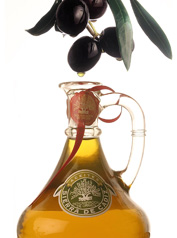
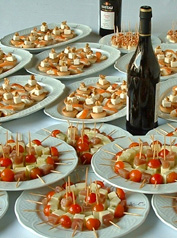
Meat dishes ranging from those that can now be considered more humble, such as the various recipes with chicken or the tests of slaughter, to the sirloin stuffed with pork or beef and the venison. Various ways to prepare El Bosque trout and other river fish or crabs and, dessert, a wide variety of sweets, Cakes, custard and porridge, which clearly show in some cases their Muslim root.
Following the order of a meal the recipes of the region, 125 of which have been collected in a book, include olives seasoned in different ways, salads, gazpachos and salmorejos, soups, scrambled and varied stews, with tagarnins, beans and asparagus as main products.
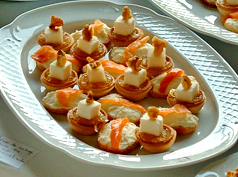
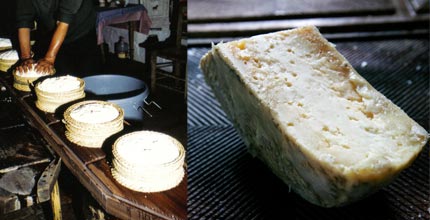
The craftsmanship of the area, in general, served as a complement to the primary sector and covered other necessities of daily life when there was not enough economic level or communication possibilities to stock up on manufactured goods, expensive and coming from abroad. Therefore, it was the craftsmanship that could afford an economy based largely on self-sufficiency, without becoming completely autarky and, as traditional knowledge, its manifestations have suffered different fates, depending on their greater or lesser adaptation to a much more open and industrialized economy.
It must be borne in mind that some of the types of crafts to which we are going to refer are already very close to industrial production and that, considering all artisan manifestations in general, we find one of the most important productive sectors of the region, due to the variety of products and the prestige that some of them have acquired, the intense specialization in this field of populations such as Ubrique and, to a lesser extent, the municipalities that surround it, or its relationship with the important cooperative movement generated in the Olvera area.
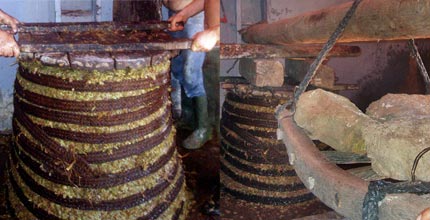
Alcalá del Valle
The main craft activities are: hand embroidery, the bolillo lace, artisanal movable miniatures, the works in enea, (activity declines due to the less and less frequent use of this product).
The artisanal activity of Alcalá has never been a sector of relevance in terms of its impact on the local economy.
It is necessary to mention five main festivities in the locality: First of all, Holy Week stands out, of great spectacularity and with important deployment of brotherhoods, the Pilgrimage of the Virgen del Valle, the Pilgrimage of San Isidro Labrador. Festivals and fairs of the patron saint of the town, San Roque and finally, in September the festivity of the patron saint of Alcalá del Valle is celebrated, the Virgin of the Valley.
- Parish Church of Our Lady of the Valley
- Monastery of Caños Santos
- Hermitage of the Lord of Mercy
- Thyme dolmens
The main craft activities are: hand embroidery, the bolillo lace, artisanal movable miniatures, the works in enea, (activity declines due to the less and less frequent use of this product).
The artisanal activity of Alcalá has never been a sector of relevance in terms of its impact on the local economy.
It is necessary to mention five main festivities in the locality: First of all, Holy Week stands out, of great spectacularity and with important deployment of brotherhoods, the Pilgrimage of the Virgen del Valle, the Pilgrimage of San Isidro Labrador. Festivals and fairs of the patron saint of the town, San Roque and finally, in September the festivity of the patron saint of Alcalá del Valle is celebrated, the Virgin of the Valley.
- Parish Church of Our Lady of the Valley
- Monastery of Caños Santos
- Hermitage of the Lord of Mercy
- Thyme dolmens
Algar
The craft activity is based on leather goods, Bags, Belts, Purses, Etc. Artisan gastronomy based on big game meat can be included in the activity.
The artisanal activity of Alcalá has never been a sector of relevance in terms of its impact on the local economy.
- Church of Santa María de Guadalupe
- Palace of Don Domingo López de Carvajal
- Town Hall
The craft activity is based on leather goods, Bags, Belts, Purses, Etc. Artisan gastronomy based on big game meat can be included in the activity.
The artisanal activity of Alcalá has never been a sector of relevance in terms of its impact on the local economy.
- Church of Santa María de Guadalupe
- Palace of Don Domingo López de Carvajal
- Town Hall
Algodonales
Artisan oils and guitars stand out. Other products within the local crafts are: high quality sweets, the saddlery (activity of great tradition in the municipality, of family type and with prospects of empowerment), the manufacture of handmade guitars (the existing workshop sells in various parts of Spain and even exports to France, Belgium, Japan and the U.S.; and its continuity is assured and appears as an activity with greater possibilities of development although business ambition is lacking), joinery (there are several carpentry standing out in a special way for the quality of their furniture, the Cooperative "Arenal"), leather goods, performed mainly by women of 18 to 35 years, is done illegally.
The artisanal activity of Alcalá has never been a sector of relevance in terms of its impact on the local economy.
- Parish Church of Santa Ana
- Hermitage of Jesus Nazarene
Artisan oils and guitars stand out. Other products within the local crafts are: high quality sweets, the saddlery (activity of great tradition in the municipality, of family type and with prospects of empowerment), the manufacture of handmade guitars (the existing workshop sells in various parts of Spain and even exports to France, Belgium, Japan and the U.S.; and its continuity is assured and appears as an activity with greater possibilities of development although business ambition is lacking), joinery (there are several carpentry standing out in a special way for the quality of their furniture, the Cooperative "Arenal"), leather goods, performed mainly by women of 18 to 35 years, is done illegally.
The artisanal activity of Alcalá has never been a sector of relevance in terms of its impact on the local economy.
- Parish Church of Santa Ana
- Hermitage of Jesus Nazarene
Border Arches
The manufacture of blankets stands out (using natural materials) and the ceramics of Jédula. The artisanal activity of Alcalá has never been a sector of relevance in terms of its impact on the local economy.
- Castle of Arcos
- Parish Church of Santa María de la Asunción
- Church of San Francisco -Convent of San Agustín
- Church of Charity -Town Hall -Parish Church of San Pedro
The manufacture of blankets stands out (using natural materials) and the ceramics of Jédula. The artisanal activity of Alcalá has never been a sector of relevance in terms of its impact on the local economy.
- Castle of Arcos
- Parish Church of Santa María de la Asunción
- Church of San Francisco -Convent of San Agustín
- Church of Charity -Town Hall -Parish Church of San Pedro
Benaocaz
We will point out the following activities: Cork (chairs and tables), leather goods (leather goods), el «croché» y punto general (Bedspreads, Tablecloths, Etc) and traditional carpentry of agricultural instruments (yoke, plough, etc.).
- Main Church
- Hermitage of San Blas
- Town hall
- Nazarí Neighborhood
We will point out the following activities: Cork (chairs and tables), leather goods (leather goods), el «croché» y punto general (Bedspreads, Tablecloths, Etc) and traditional carpentry of agricultural instruments (yoke, plough, etc.).
- Main Church
- Hermitage of San Blas
- Town hall
- Nazarí Neighborhood
Bornos
We point out the works in esparto, wicker, the palm, the enea, olive rods, the cane, wood and leather. The tools manufactured have had a close relationship with the prevailing economic activity in this area, agriculture. The cerones, the capacha, hats and palm belts, were necessary complements to cope more easily with the working day. For the construction of typically rural houses such as huts, palm was used in the same way. Objects intended for the home and purely artisans are the carpet, the blinds and the different baskets (for bread, eggs, etc.). Another craft activity to consider, is screen printing. Even if it is collected as an industrial activity, the workshop exists in the locality works with artisanal machines that allow it to develop the required works.
- Blood Hospital
- Convent of Corpus Crhisti
- Castle and Palace of the Ribera
- Parish Church of Santo Domingo de Guzmán
- Hermitage of Calvary
- Hermitage of the Resurrection
We point out the works in esparto, wicker, the palm, the enea, olive rods, the cane, wood and leather. The tools manufactured have had a close relationship with the prevailing economic activity in this area, agriculture. The cerones, the capacha, hats and palm belts, were necessary complements to cope more easily with the working day. For the construction of typically rural houses such as huts, palm was used in the same way. Objects intended for the home and purely artisans are the carpet, the blinds and the different baskets (for bread, eggs, etc.). Another craft activity to consider, is screen printing. Even if it is collected as an industrial activity, the workshop exists in the locality works with artisanal machines that allow it to develop the required works.
- Blood Hospital
- Convent of Corpus Crhisti
- Castle and Palace of the Ribera
- Parish Church of Santo Domingo de Guzmán
- Hermitage of Calvary
- Hermitage of the Resurrection
The Forest
- Parish Church of Our Lady of Guadalupe
- Molino del Duque
- Parish Church of Our Lady of Guadalupe
- Molino del Duque
Hold on
- Church of Our Lady of Grace
- Castle of Fatetar
- Hermitage of Santiago
- Gajetary Castle
- House of the Cilla
- Church of Our Lady of Grace
- Castle of Fatetar
- Hermitage of Santiago
- Gajetary Castle
- House of the Cilla
The Gastor
- Dolmen of the Giant
- Parish Church of San José -Grazalema.
- Parish of the Incarnation
- Church of the Aurora -Church of San José
- Dolmen of the Giant
- Parish Church of San José -Grazalema.
- Parish of the Incarnation
- Church of the Aurora -Church of San José
Grazalema
Olvera
- Moorish castle
- Parish Church of Our Lady of the Incarnation
- Hermitage of Our Lady of Remedies
- Moorish castle
- Parish Church of Our Lady of the Incarnation
- Hermitage of Our Lady of Remedies
King's Meadow
- Roman city of Iptuci
- Parish Church of Nuestra Señora del Carmen
- Hermitage of the Virgin of the Mountains
- Roman city of Iptuci
- Parish Church of Nuestra Señora del Carmen
- Hermitage of the Virgin of the Mountains
Puerto Serrano
Setenil de las Bodegas
Torre-Alháquime
Ubrique
Villaluenga del Rosario
Villamartín
Zahara de la Sierra
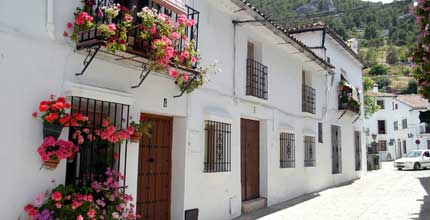
In the abrupt relief of the Sierra de Grazalema, For example, highlight the highest peaks in the entire province. These mountain massifs are formed mainly by Jurassic and Lyassic limestone materials. (Secondary), resting on sandstones, Keuper marls and plasters. Therefore, its limestone origin allows the number of filtered water in the subsoil to be very abundant, to which is added its exceptional rainfall regime (the highest rainfall of the peninsula due to a curious geographical and atmospheric phenomenon) que termina conformando una amplia red hidrológica que en su mayor parte desemboca en la cuenca del Guadalete. En él se inscriben los términos municipales de Grazalema, Zahara de la Sierra, The Gastor, Villaluenga del Rosario, Benaocaz, Ubrique, El Bosque y Prado del Rey.
Su elevada pluviosidad (hasta 2.300 litros / m cuadrado) y su régimen eólico ha transformado el sustrato calizo y ha favorecido la formación de un paisaje kárstico de excepcional belleza con formas espectaculares derivadas de la erosión de este material. Al agreste relieve se une la presencia de infinidad de cuevas y profundas simas, que convierten a la comarca en el paraíso de los espeleólogos.
En detalle, podemos decir que dentro de lo que hoy denominamos genéricamente como “Sierra de Grazalema”, a cluster of interconnected mountain ranges are developed and among which our most typical villages are inscribed.
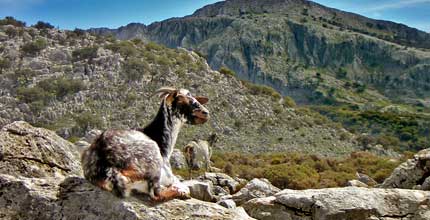
La zona de las Sierras Subbéticas pertenece geológicamente a épocas triásicas y jurásicas también, but its heights are much lower than those of the Grazalema-Ronda massif. It mainly occupies the municipalities of Olvera, Torre-Alháquime, Algodonales and Villamartín. They are really, a series of small isolated saws, surrounded by tertiary lands that descend rapidly towards the valley excavated by the Guadalete during the Quaternary. The most important are those of the Mogote de Algodonales, the Sierra de Olvera, the Lagarín next to El Gastor, the Sierra de las Cabras and pajarete among others.
The mountain climate can be considered as temperate Mediterranean climate type, modified by its location on the edge of the Atlantic Ocean. It has a long warm and dry season, pero sus particulares características geográficas y proximidad al mar condicionan la existencia de una serie de variedades climáticas, con connotaciones más húmedas en nuestra comarca.
Predominan en general las temperaturas moderadas, así como un característico régimen de vientos, alcanzando valores más extremos en las sierras del Nordeste debido a la mayor continentalidad y altitud. Esta moderación de las temperaturas no descarta que en algunos puntos pueden ser muy bajas durante el invierno y muy altas durante el verano, por lo que durante los meses de invierno puede nevar en los puntos más altos y hacer días de mucho calor y sequedad en verano.
Todas estas sierras dan cobijo a una amplia fauna y flora, mucha de ella endémica. Al ya citado Pinsapo, se le unen bosques de encinares, alcornocales y quejigos, a los que se unen los matorrales del sotobosque andaluz y las comunidades riparias en las riberas de los ríos (sauces, fresnos y olmos).


